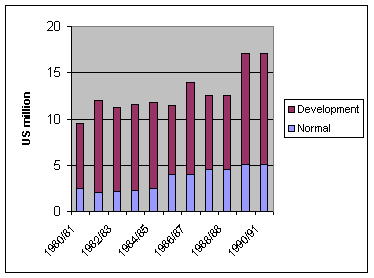Bangladesh's forestry sector consists mainly of the primary production of forest products. Excluding pulp and paper, the secondary sector is weakly developed and under-capitalized; it features obsolete technology and badly designed or worn out equipment. Tertiary manufacturing is even less well developed. Primary production of logs and bamboo, the main industrial products, comes mostly from private land and secondly from government managed forest land. Government forests serve the organized manufacturing section, especially the government sector.
Table 3 Principal Primary and Secondary Wood Using Industry
Industry |
Unit |
Number |
Annual Volume (000) | |
Capacityb |
Production | |||
Primary |
||||
Sawnwood |
m3 |
4,492 |
5,868.0 |
2,726.0 |
Pulp |
ADT |
1 |
30.5 |
18.0d |
Newsprint |
ADT |
1 |
50.8 |
43.5d |
Paper |
ADT |
3 |
136.0 |
61.0d |
Rayon |
ADT |
1 |
2.4 |
1.2d |
Cellophane |
ADT |
na |
1.0 |
na |
Particleboard |
m2 |
2 |
4,142.0 |
2,748d |
Hardboard |
m2 |
2 |
3,121.0 |
1,589d |
Plywood |
||||
- Plywood |
m2 |
8 |
2,787.0 |
1,248 |
- Tea cheat |
no |
8 |
||
Match |
gross boxes |
18 |
15,000.0 |
12,400 |
Pencil |
gross |
1 |
194,000.0 |
na |
Secondary |
||||
Seasoning |
m3 |
6 |
28.3 |
na |
Treatment |
m3 |
6 |
62.3 |
na |
Bobbin |
no |
12 |
3,100.0 |
na |
Furniture |
m3 |
1 |
1,700.0 |
na |
Door/Window |
m2 |
3 |
83.6 |
na |
a = Mechanical b = 1989 c = 1989/90 d = 1990/91 e = 1979/80 f = BFRI, 1992
g = Excludes pitsaws
Figure 4 - Actual recent forest department expendiutres

The estimated demand for round logs in the country in 1991 was 4.26 million m3 of which 0.25 million was consumed by process industries and the rest by households. In comparison, the sustainable local supply was 1.28 million m3. Roundwood consists of both direct and derived demand for domestic consumption and industrial processing. A recent moratorium on felling created a shortage in the market. This, along with tribal insurgency problems in hill districts, seriously affects some government-owned forest industries.
Wood markets are fed both by recognized and unrecognized sources of log supply. Among the unrecognized sources, unrecorded production, illicit felling and smuggling from neighbouring countries are important. A minimum figure of 20% is commonly accepted as coming from unrecognized sources.
Panel product marketing in Bangladesh is in its infancy. Potential for growth exists, but lack of standards; market promotion and existing product surplus creates the lowest production, sales and consumption in developing countries. Local preference is for solidwood products; market promotion and effective pricing is necessary to help expand this market. The demand for paper, paper products and newsprint is increasing, but lacks sufficient pulpwood and pulp processing industries, new demand being met through imports. Forest development, with proper emphasis on pulpwood plantations and other commercial softwoods, could save the existing paper related industries and encourage future expansion.
Environmental impact assessment experience is limited in Bangladesh, and legislation and policy are weak. Significant training and national capacity building is needed, within both the Forest and Environment Departments. There is an absence of effective policy, legislation, and implementation mechanisms for conservation, protected area management, wildlife management and biodiversity. For example, environmental impact guidelines for the forestry sector do not exist in Bangladesh and need developing. Finally, while there is substantial international agreement on the need for biodiversity protection, there remains the question of who should pay for such programmes, as well as pollution mitigation measures. Owing to its population and limited resources, Bangladesh can ill afford not to fully utilize its limited resources. The problem is how to manage renewable resources without depleting them or their productive capacities.
Environment Issues · Declining plant and animal varieties. · Present exploitation levels are not sustainable. · Productivity is unacceptably low. · Social equity remains unresolved. · Absence of effective environment monitoring. |
Conserving ecological processes is critical for Bangladesh and its extremely diverse species compliment. The regulation of these processes by micro organisms, animal and humans has impacts on the complex relationships within and between species, habitats and ecosystems. This diversity is substantially threatened, particularly through man-induced changes.
Past and present forest resource use and exploitation patterns, if allowed to continue, will result in further severe depletion of growing stock and reduced varieties of flora and fauna. These past patterns are not sustainable. To what extent can the remaining natural forests in the country be exploited, without causing irreversible and permanent damage to the natural heritage of the country? Given the pressures on land in Bangladesh, how much can realistically be kept under a protected area system?
The net result of all the plantation activities over the last 100 years in Bangladesh has been negative, as has the traditional approach of the Forest Department in designating reserves for revenue generation while not contributing to providing basic needs for local people. The productivity of forest management techniques requires a dramatic increase. How can this best be achieved, given the existing severe social and institutional constraints?
Social equity has not been seriously attempted before and the forestry sector has not fostered the participation of people in planning, implementing, monitoring and evaluating sectoral programmes. Biomass production, development of non wood forest products, and community participation and benefit-sharing are not adequately addressed. To what extent can equity in forestry activities be addressed through participatory mechanisms?
Bangladesh has only recently created institutional mechanisms for environmental management through the Ministry of Environment and Forests and the Department of Environment. A major issue is how to build the institutional capacity and how to use existing national level expertise more in environmental impact assessment, monitoring, and evaluation of the forest sector.